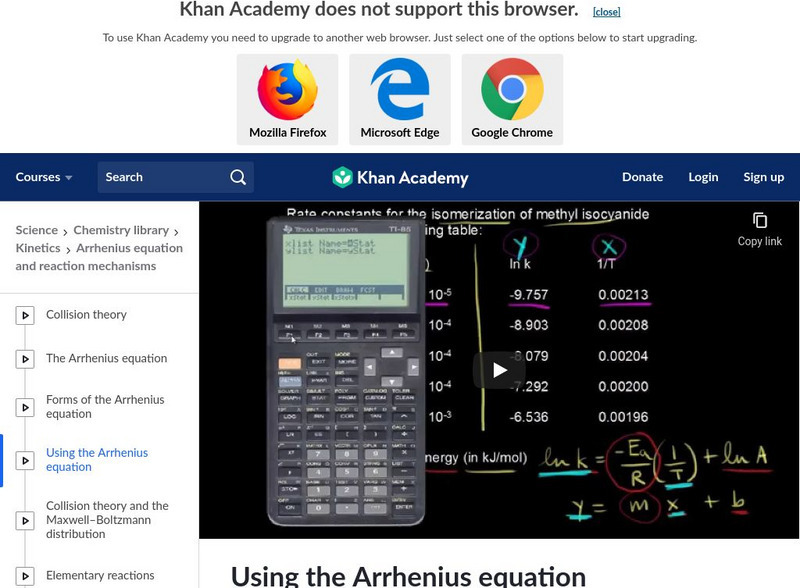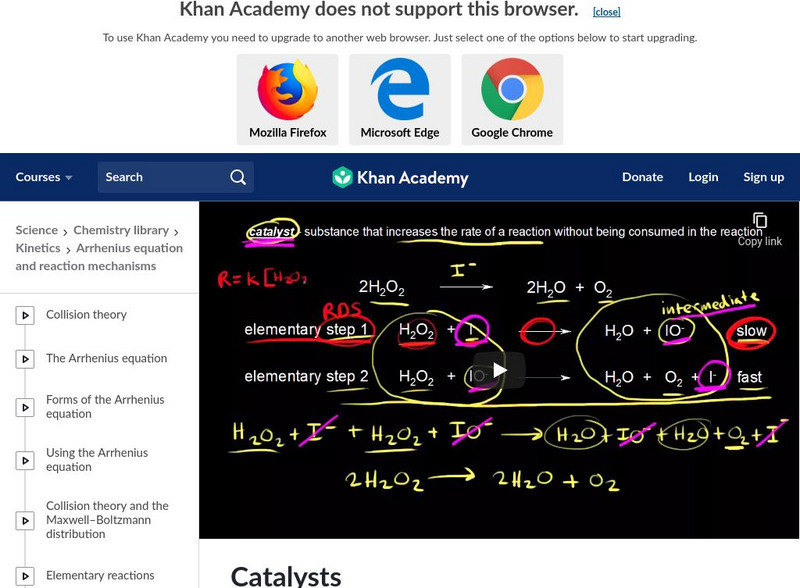Khan Academy
Khan Academy: Finding Units of Rate Constant K
Discover how to find the units for the rate constant k for a zero, first, or second order reaction. [5:05]
Khan Academy
Khan Academy: Experimental Determination of Rate Laws
Understand this example using initial rates to find the order in each reactant, the overall order, and the rate constant k. [12:21]
Khan Academy
Khan Academy: First Order Reaction (With Calculus)
Deriving the integrated rate law for first-order reactions using calculus. How you can graph first-order rate data to see a linear relationship. [7:07]
Khan Academy
Khan Academy: Plotting Data for a First Order Reaction
Identify an example of graphing first-order rate data to see a linear relationship and calculating rate constant k from the slope. [9:13]
Khan Academy
Khan Academy: Half Life of a First Order Reaction
Understand how to derive the half-life equation of a first-order reaction starting from the integrated rate law. [8:12]
Khan Academy
Khan Academy: First Order Reaction Example
An example of how to use the integrated rate law to solve for time and concentration. Understand how to calculate the half-life for a first-order reaction. [10:15]
Khan Academy
Khan Academy: Rate Constant K From Half Life Example
An example problem shows how to find the rate constant k from the half-life of a first-order reaction. [6:10]
Khan Academy
Khan Academy: Second Order Reaction (With Calculus)
Understand the process of deriving the integrated rate law for second order reactions using calculus. Know how to graph second order rate data to see a linear relationship. [7:09]
Khan Academy
Khan Academy: Plotting Data for a Second Order Reaction
An example of graphing second order rate data to see a linear relationship, and calculating rate constant k from the slope is introduced from Khan Academy. [8:02]
Khan Academy
Khan Academy: Half Life of a Second Order Reaction
Recognize how to derive half-life equation of a second-order reaction starting from the integrated rate law. [7:04]
Khan Academy
Khan Academy: Second Order Reaction Example
Review this example of using integrated rate law to solve for concentration, and calculating the half-life for a second-order reaction. [8:03]
Khan Academy
Khan Academy: Zero Order Reaction (With Calculus)
Understand the process of deriving the integrated rate law for zero-order reactions using calculus. Identify how to graph zero order rate data to see a linear relationship. [9:46]
Khan Academy
Khan Academy: Collision Theory
An introduction to collision theory and activation energy is presented. [8:42]
Khan Academy
Khan Academy: Arrhenius Equation
Definition of rate constant k, the pre-exponential factor A, and activation energy are introduced. Understand how the exponential part of the Arrhenius equation depends on activation energy and temperature. [9:21]
Khan Academy
Khan Academy: Forms of the Arrhenius Equation
Know how to write different forms of the Arrhenius equation. Use the Arrhenius equation to look at how changing temperature and activation energy affects collisions. [6:36]
Khan Academy
Khan Academy: Using the Arrhenius Equation
Know how to use the Arrhenius equation to calculate the activation energy. [11:01]
Khan Academy
Khan Academy: Maxwell Boltzmann Distribution
Sal explains how to use the Maxwell-Boltzmann distribution to visualize the distribution of speeds of particles at different temperatures. [9:26]
Khan Academy
Khan Academy: Elementary Rate Laws
Sal helps viewers understand how to write rate laws for unimolecular and bimolecular elementary reactions. [5:30]
Khan Academy
Khan Academy: Mechanisms and the Rate Determining Step
An introduction to mechanisms and the rate determining step. Review the example of finding rate law of multistep reaction with an initial slow step. [8:36]
Khan Academy
Khan Academy: Catalysts
Sal will illustrate how a catalyst speeds up a reaction by lowering the activation energy. [7:24]
Khan Academy
Khan Academy: Chemistry: Mass Defect and Binding Energy
Using the mass defect to calculate the energy released when a helium nucleus formed. Introduction to the nuclear strong force. [11:24]
Khan Academy
Khan Academy: Nuclear Stability and Nuclear Equations
Using the ratio of neutrons to protons to figure out of a nucleus will be stable or radioactive. [8:20]
Khan Academy
Khan Academy: Types of Decay
Sal illustrates the different types of decay: Alpha, Beta, Gamma Decay and Positron Emission. [17:00]
Khan Academy
Khan Academy: Writing Nuclear Equations for Alpha, Beta, and Gamma Decay
Sal will discuss how to write nuclear equations for alpha, beta, and gamma decay when studying radioactive decay. [8:02]























